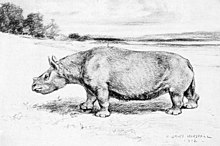Teleoceras(Greek: "perfect" (teleos), "horn" (keratos)[4]) is an extinctgenusofrhinocerotid.It lived inNorth Americaduring theMioceneandPlioceneepochsduring theHemingfordianto the end ofHemphillianfrom around 17.5 to 4.9 million years ago.[5][6]It grew up to lengths of 13 feet (4.0 meters) long.[7]
| Teleoceras | |
|---|---|

| |
| Specimen at theNatural History Museum of LA | |

| |
| 1913T. fossigerillustration byRobert Bruce Horsfall. | |
| Scientific classification | |
| Domain: | Eukaryota |
| Kingdom: | Animalia |
| Phylum: | Chordata |
| Class: | Mammalia |
| Order: | Perissodactyla |
| Family: | Rhinocerotidae |
| Subfamily: | †Aceratheriinae |
| Genus: | †Teleoceras Hatcher,1894 |
| Type species | |
| †Teleoceras major | |
| Species[1] | |
| |
| Synonyms | |
Teleoceraswent extinct in North America alongsideAphelopsat the end of theHemphillian,most likely due to rapid climate cooling, increased seasonality and expansion ofC4grasses, as isotopic evidence suggests that the uptake of C4plants was far less than that in contemporary horses.[6]TheGray Fossil Sitein northeastTennessee,dated to 4.5-5 million years ago, hosts one of the latest-known populations ofTeleoceras,Teleoceras aepysoma.[8]
Description
editTeleocerashad much shorter legs than modern rhinos, and a barrel chest, making its build more like that of ahippopotamusthan a modern rhino. Based on this description,Henry Fairfield Osbornsuggested in 1898 that it was semi-aquatic and hippo-like in habits. This idea persisted for about a century, but has recently been discounted by isotopic evidence.[6]
Some species ofTeleocerashave a small nasal horn, but this appears to be absent in other species such asT. aepysoma.[9]Teleocerashas high crowned (hypsodont) molar teeth, which has historically led to suggestions that the species were grazers.Dental microwearandmesowearanalysis alternatively suggest abrowsingor mixed feeding (both browsing and grazing) diet.[10]Carbon and oxygen isotope analysis of tooth enamel suggests hippo-like grazing habits, but not aquatic.[11]
Sexual dimorphism
editTeleoceraswas sexually dimorphic. Males were larger, with larger tusks (lower incisors), a more massive head and neck, and significantly larger forelimbs. As a result ofbimaturism,females matured and stopped growing before males, which is often seen in extant polygynous mammals. Males may have fought for mating rights; healed wounds on skulls have been observed, and healed broken ribs are not uncommon (although not all have their sexes determined). This is further supported by the breeding age female-to-male ratio in the Ashfall Fossil Beds being 4.25:1. There is also a rarity of young adult males preserved at Ashfall, which may be accounted for if they formed bachelor herds away from females and dominant bulls.[11]
Discovery
editAshfall Fossil Beds
editTeleoceras majoris the most common fossil in theAshfall Fossil BedsofNebraska.Over 100 intactT. majorskeletons are preserved in ash from theBruneau-Jarbidgesupervolcanic eruption.Of the 20+ taxa present,T. majorwas buried above the rest, being the last of the animals to succumb (small animals died faster), several weeks or months after thepyroclastic airfall event.Their skeletons show evidence of bone disease, iehypertrophic pulmonary osteodystrophy(HPOD), as a result of lung failure from the fine volcanic ash.[12]
Most of the skeletons are adult females and young, the breeding age female-to-male ratio being 4.25:1. There is also a rarity of young adult males. If the rhinos at Ashfall represent a herd, this may be accounted for if young adult males formed bachelor herds away from females and dominant bulls. The age demographic is very similar to that of modernhippoherds, as amongst the skeletons, 54% are immature, 30% are young adults, and 16% are older adults.[11]
The greatest concentration of Ashfall fossils is housed in a building called the "Rhino Barn", due to the prevalence ofT. majorskeletons at the site, of which most were preserved in a nearly complete state. One extraordinary specimen includes the remains of aTeleocerascalf trying to suckle from its mother.[13]
References
edit- ^Prothero, 2005, p. 94.
- ^McKenna & Bell, 1997, p. 483.
- ^Prothero, 2005, p. 122.
- ^"Glossary. American Museum of Natural History".Archived fromthe originalon 20 November 2021.
- ^(Prothero, 2005)
- ^abcWang, B.; Secord, R. (2020)."Paleoecology ofAphelopsandTeleoceras(Rhinocerotidae) through an interval of changing climate and vegetation in the Neogene of the Great Plains, central United States ".Palaeogeography, Palaeoclimatology, Palaeoecology.542:109411.Bibcode:2020PPP...54209411W.doi:10.1016/j.palaeo.2019.109411.
- ^"Region 4: The Great Plains".geology.teacherfriendlyguide.org.Retrieved2021-06-26.
- ^Short, Rachel A; Wallace, Steven C."A New Species of Teleoceras (Mammalia, Rhinocerotidae) from the Late Hemphillian of Tennessee".
{{cite journal}}:Cite journal requires|journal=(help) - ^Short, Rachel; Wallace, Steven; Emmert, Laura (2019-04-27)."A new species of Teleoceras (Mammalia, Rhinocerotidae) from the late Hemphillian of Tennessee".Bulletin of the Florida Museum of Natural History.56(5): 183–260.doi:10.58782/flmnh.kpcf8483.ISSN2373-9991.
- ^Mihlbachler, Matthew C.; Campbell, Daniel; Chen, Charlotte; Ayoub, Michael; Kaur, Pawandeep (February 2018)."Microwear–mesowear congruence and mortality bias in rhinoceros mass-death assemblages".Paleobiology.44(1): 131–154.Bibcode:2018Pbio...44..131M.doi:10.1017/pab.2017.13.ISSN0094-8373.S2CID90987376.
- ^abcMead, Alfred J. (2000)."Sexual dimorphism and paleoecology in Teleoceras, a North American Miocene rhinoceros".Paleobiology.26(4): 689–706.doi:10.1666/0094-8373(2000)026<0689:SDAPIT>2.0.CO;2.ISSN0094-8373.
- ^Tucker, S.T.; Otto, R.E.; Joeckel, R.M.; Voorhies, M.R. (April 2014),"The geology and paleontology of Ashfall Fossil Beds, a late Miocene (Clarendonian) mass-death assemblage, Antelope County and adjacent Knox County, Nebraska, USA",Geologic Field Trips along the Boundary between the Central Lowlands and Great Plains: 2014 Meeting of the GSA North-Central Section,Geological Society of America, pp. 1–22,doi:10.1130/2014.0036(01),ISBN978-0-8137-0036-6,retrieved2024-08-13
- ^"Ashfall Fossil Beds".Archived fromthe originalon 2011-05-18.Retrieved2005-12-13.
Bibliography
edit- McKenna, Malcolm C., and Bell, Susan K. 1997.Classification of Mammals Above the Species Level.Columbia University Press, New York, 631 pp.ISBN0-231-11013-8
- Prothero, Donald R. 2005.The Evolution of North American Rhinoceroses.Cambridge University Press, Cambridge, 218 pp.ISBN0-521-83240-3
External links
editMedia related toTeleocerasat Wikimedia Commons